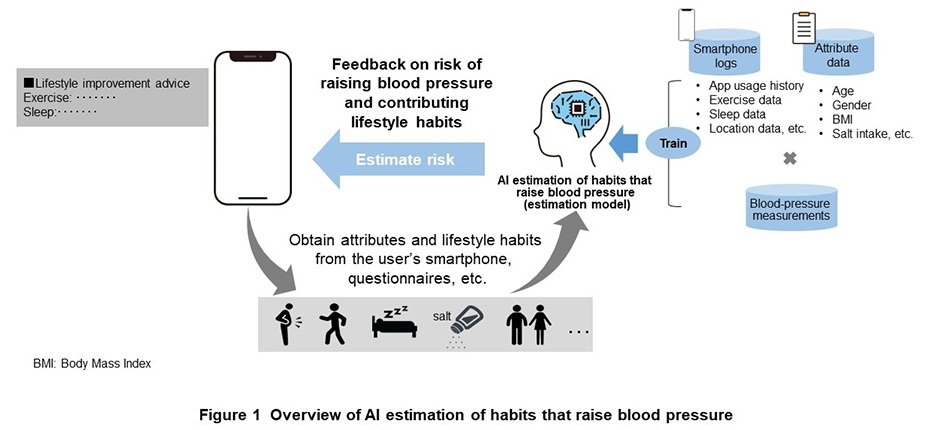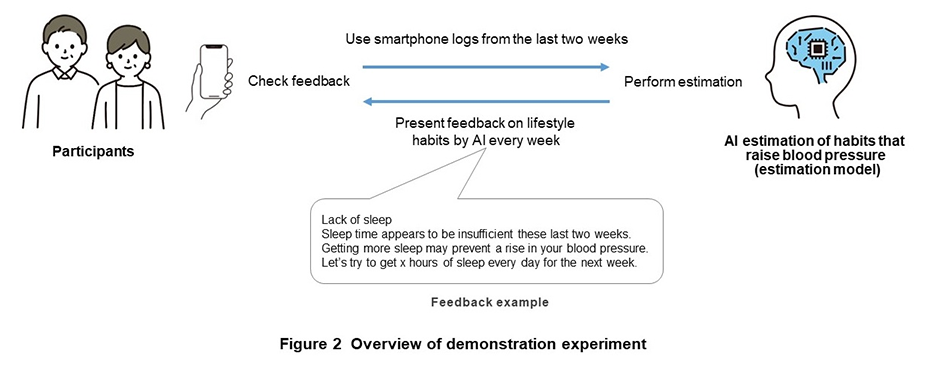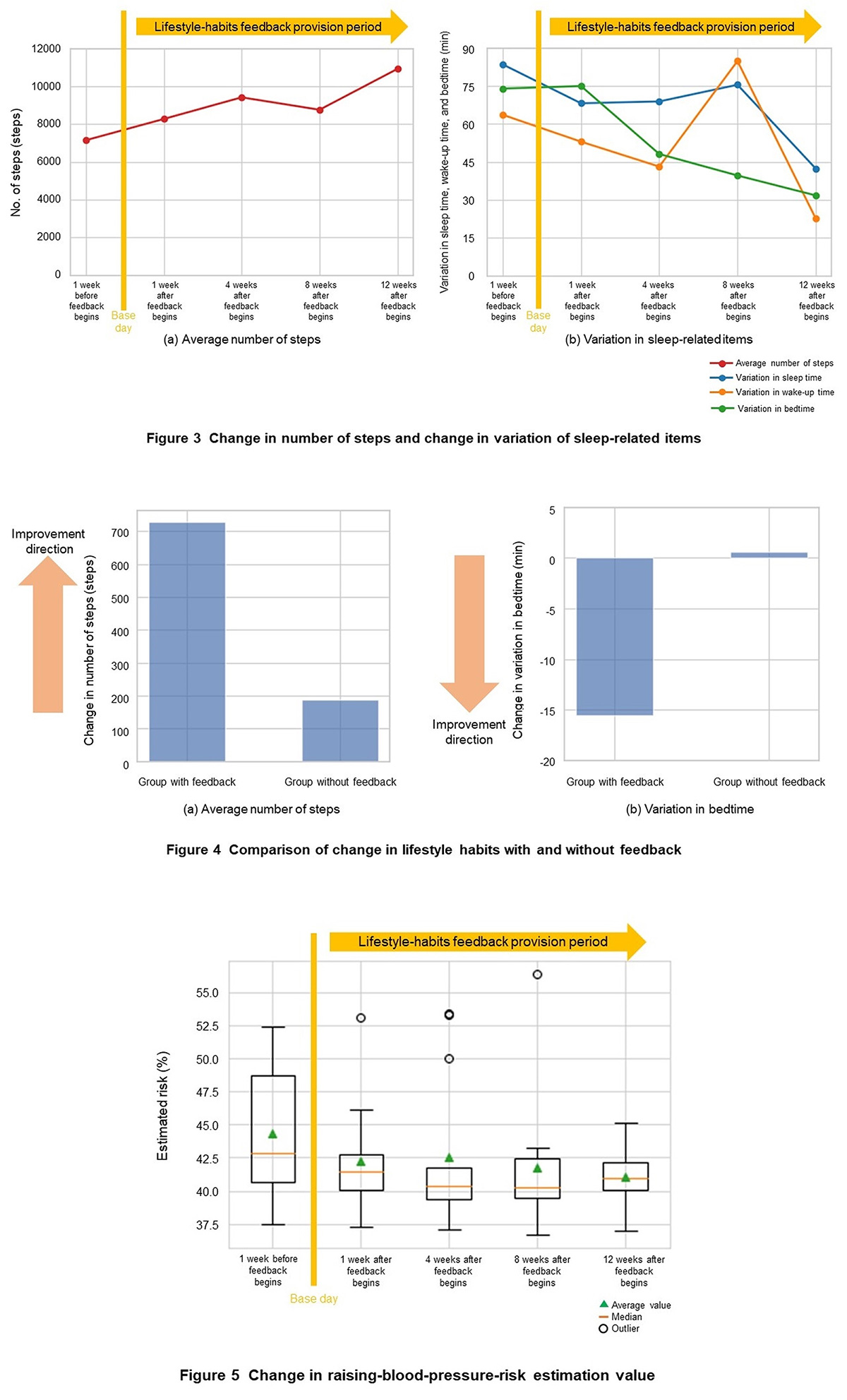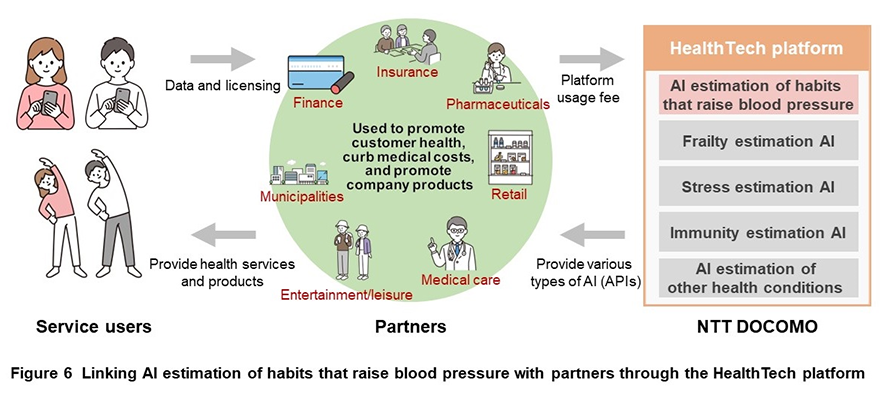Special Articles on AI for Customer Support in Diverse Fields
AI Estimation of Habits that Raise Blood Pressure Using Smartphone Logs
Healthcare Behavioral Modification Curbing Medical Costs
Yuki Ikezoe, Naoki Yamamoto and Takafumi Yamauchi
X-Tech Development Department
Hiroki Arakawa
Smart World Business, Business Solution Division, NTT Communications Corporation
Abstract
Early detection and early intervention of hypertension is important from the viewpoint of extending healthy life expectancy and curbing medical costs, but blood-pressure values differ depending on the time of measurement, and in addition, there are practically no subjective symptoms accompanying a rise in blood pressure. It has therefore been difficult to grasp actual conditions in relation to hypertension. Against this background, NTT DOCOMO has developed AI-based technology for estimating habits that raise blood pressure using smartphone logs. This technology can lead to behavioral modification in the user by making it easy to grasp the risk of raising blood pressure without having to make blood-pressure measurements and by providing individual advice on making improvements in lifestyle habits that can raise that risk.
01. Introduction
-
NTT DOCOMO considers the medical/healthcare field to be ...
Open

NTT DOCOMO considers the medical/healthcare field to be a target of attention, and it has been providing users with services such as “d-Healthcare” and “Kenko-mileage” to help motivate them to maintain and improve their health on a daily basis. With the aim of achieving a society in which anyone can maintain and improve one’s health while going about daily life, NTT DOCOMO has developed AI technologies called “stress estimation AI” and “frailty estimation AI” for estimating people’s state of health from smartphone logs [1][2]. Today, as well, we are pursuing the development of technologies that can estimate a person’s state of health in a more multifaceted manner and encourage maintenance and improvement of one’s health toward behavioral modification.
Hypertension is a lifestyle disease involving a variety of lifestyle habits such as excessive intake of salt, obesity, lack of exercise, lack of sleep, smoking, and excessive drinking. In Japan, the number of hypertension patients is estimated to be about 43 million while the number of hospitalized patients with hypertensive cardiovascular disease*1 or cerebrovascular disease*2 caused by severe hypertension comes to about 140,000 [3][4]. To extend healthy life expectancy*3 and curb medical costs that continue to climb, early intervention by early detection of hypertension, improvement in lifestyle habits, and treatment by a physician are important to prevent an increase in the severity of this disease.
However, blood pressure values can easily fluctuate depending on the time of measurement, and there are practically no subjective symptoms accompanying a rise in blood pressure. These features make it difficult to correctly grasp the state of a person’s blood pressure, and there are many cases in which it is left unchecked until it reaches a severe stage. As a result, the current situation is that about 30% of hypertension patients are not being treated for high blood pressure or are unable to recognize that they have high blood pressure [5]. Although measuring blood pressure daily using a blood-pressure monitor can be effective for early detection of hypertension, only about 10% of men and women in the 30–74 age group—an extremely small number—are in the habit of measuring blood pressure on a daily basis [6].
At NTT DOCOMO, considering that blood pressure rises due to the effects of unhealthy lifestyle habits such as lack of exercise or lack of sleep, we came to focus on the fact that much information on user lifestyle habits is reflected in the logs of smartphones that have become an indispensable part of people’s lives. In this way, we achieved “AI estimation of habits that raise blood pressure” as a technology that can estimate the risk of raising blood pressure simply through the everyday use of a smartphone. This technology makes it easy to comprehend this risk without having to make daily blood-pressure measurements that have heretofore been a major hurdle to determining the state of one’s blood pressure. It can also provide each user with advice on how to make improvements in lifestyle habits that raise the risk of raising blood pressure. It can therefore support behavioral modification that can lead to maintenance and improvement of one’s health.
In this article, we provide an overview of AI estimation of habits that raise blood pressure, present the results of a demonstration experiment, and describe functional implementation in commercial services.
- Hypertensive cardiovascular disease: General term for diseases of the heart caused by hypertension.
- Cerebrovascular disease: General term for diseases of the brain caused by deterioration of the blood vessels in the brain.
- Healthy life expectancy: The time during which a person can go about daily life without any physical or mental health problems.
-
2.1 Building an Estimation Model
Open

An overview of AI estimation of habits that raise blood pressure is shown in Figure 1. The proposed technology builds an estimation model that treats a smartphone log as an explanatory variable*4 and the occurrence or non-occurrence of elevated blood pressure according to blood-pressure measurements as an objective variable*5. Here, blood-pressure measurements are used only when building the estimation model, so once the model has been completed, the risk of raising blood pressure can be estimated by simply collecting smartphone logs without having to measure blood pressure.
We collected a dataset for use in building the estimation model by performing a data collection test. In this test, we first obtained the consent of about 200 men and women in the 40–60 age group and provided each participant with a data-collection app and a blood-pressure monitor. We then asked for their cooperation in providing personal attribute data and approximately two months worth of smartphone logs and in recording daily blood-pressure measurements and diet. (We note here that we did not use diet recording in model building this time but plan to use it in future enhancements.)
- We collected smartphone logs assumed to be related to lifestyle habits such as installed-app usage history, exercise data, sleep data, location data, etc. We analyzed those logs in our own company’s data analysis environment and created explanatory variables such as average number of steps and average sleep time that are considered to be related to a rise in blood pressure.
- Taking into account the effects of daily fluctuations in blood pressure, we calculated the average value of blood pressure measurements per week, labeled the average value two weeks after a base week as to whether blood pressure rose compared to that base week, and treated that label as an objective variable.
- We then constructed an estimation model by using machine learning*6 to learn the relationship between two weeks worth of explanatory variables created from smartphone logs up to a base day and an objective variable obtained by comparing and labeling the 7-day average blood pressure for the week after the base day and the 7-day average blood pressure from two weeks to one week prior to the base day. On evaluating the performance of this estimation model, we obtained a sensitivity*7 of 0.71 and a specificity*8 of 0.61.
2.2 Feedback Encouraging Behavioral Modification
Maintaining healthy lifestyle habits is essential to mitigating the risk of raising blood pressure. While it is thought that presenting this risk using an estimation model can temporarily heighten the user’s health awareness and desire to improve lifestyle habits, which lifestyle habits should be improved cannot be understood from that information alone, so it is difficult to encourage the user to continue to adopt healthy lifestyle habits.
For this reason, AI estimation of habits that raise blood pressure does not simply present the risk of raising blood pressure but also presents those lifestyle habits that should be improved based on each user’s estimation results. This approach promotes ongoing behavioral modification toward healthy user lifestyle habits.
By using explanatory variables related to lifestyle habits created from smartphone logs and making use of Explainable AI (XAI)*9 technology, the proposed technology extracts explanatory variables that contribute to increasing the risk of raising blood pressure for each user. It then selects items from these extracted explanatory variables that the user can understand and can actually take action to improve, and it presents to the user the explanatory variables that increase the risk the most as lifestyle habits that should be improved. The risk of raising blood pressure and the lifestyle habits that should be improved are presented once a week to the user to encourage ongoing behavioral modification to mitigate that risk.
- Explanatory variable: An item that affects another item targeted for estimation (objective variable (see *5)).
- Objective variable: An item targeted for estimation in an estimation model like machine learning.
- Machine learning: A mechanism for learning the relationship between inputs and outputs on a computer through statistical processing of example data.
- Sensitivity: In this article, the ratio of persons estimated by an estimation model to have elevated blood pressure among persons that actually have elevated blood pressure.
- Specificity: In this article, the ratio of persons estimated by an estimation model to have no elevated blood pressure among persons that actually have no elevated blood pressure.
- XAI: AI that can be explained. Technology that presents reasons or rationales for AI output that humans can interpret.
-
3.1 Demonstration Experiment Setup
Open

We conducted a demonstration experiment in Jinsekikogen Town, Hiroshima Prefecture to verify the effects of using AI estimation of habits that raise blood pressure on lifestyle-habits improvement and mitigation of the risk of raising blood pressure [7]. Fifty men and women aged 50 and up residing in Jinsekikogen Town agreed to participate in this experiment. We lent these participants smartphones equipped with an app designed for this experiment and asked each of them to lead their daily lives while walking around with this smartphone as much as possible for a period of about three months. During the experimental period, we collected smartphone logs from those smartphones and input into the estimation model explanatory variables related to lifestyle habits created using these logs. Advice (feedback) on mitigating the risk of raising blood pressure and on improving lifestyle habits that increase this risk the most as output from the model were presented to participants via the smartphone app once a week (Figure 2).
3.2 Demonstration Experiment Results
1) Verifying Lifestyle-habits Improvement Effect
(a) Change in number of steps and sleep before and after feedback
To verify the effect of using AI estimation of habits that raise blood pressure in improving lifestyle habits, we analyzed changes in participants’ number of steps and sleep during the demonstration experiment period. Figure 3 shows change in number of steps and change in variation of sleep-related items (sleep time, wake-up time, bedtime). With regard to sleep-related items (variation), waking up and going to bed at the same time every day corresponds to a variation of 0 minutes. Variation becomes larger the more irregular is the participant’s life.
Treating the day in which feedback by AI estimation of habits that raise blood pressure is provided for the first time as the base day, comparing the average number of steps one week before the base day with that one week after the base day reveals a significant increase of approximately 1,100 steps. It can also be seen that a high number of steps could be maintained compared with that before the beginning of feedback even in the periods after that initial feedback.
Next, variation in sleep-related items tended to decrease throughout the demonstration experiment period, and on comparing variation at the time of the end of the experiment with that before the beginning of feedback, it was found that a significant decrease in variation of approximately 30 minutes occurred for any of the sleep-related items. Since it can be considered that the smaller the variation in sleep-related items, the greater is the possibility that a regular lifestyle is being led, it can be said that sleep rhythm improved through this demonstration experiment.
We consider that the use of AI estimation of habits that raise blood pressure heightened participants’ awareness of health leading to behavioral modification and the improvement of one’s lifestyle habits.
(b) Difference in lifestyle-habits improvement effect with and without feedback
First, we classified participants into a group that received feedback on average number of steps and on variation in bedtime as lifestyle habits that should be improved according to AI estimation of habits that raise blood pressure and a group that did not (group that received separate feedback on lifestyle habits that should be improved). We then analyzed the difference in the lifestyle-habits improvement effect with and without feedback for the targeted lifestyle habits. Figure 4 shows the results of calculating differences between the group that received feedback and the group that did not for average number of steps and variation in bedtime. It was found that the average number of steps of the group that received feedback increased by approximately 500 steps and variation in bedtime decreased by approximately 15 minutes in comparison with those of the group that did not receive feedback, a significant difference in both cases. We therefore consider that identifying lifestyle habits that should be improved from AI estimation of habits that raise blood pressure and presenting them to the user made it easy to get the user’s attention on specific lifestyle habits, resulting in a significant improvement effect in behavioral modification.
2) Verifying Raising-blood-pressure-risk Mitigation Effect
We analyzed the effect of using AI estimation of habits that raise blood pressure in mitigating the risk of raising blood pressure. Figure 5 shows change in the raising-blood-pressure-risk estimation value for participants during the demonstration experiment period. On comparing the raising-blood-pressure-risk estimation value before and after the initial feedback, a significant decrease of approximately 2% in the average value was observed. This value decreased by approximately 3% at the end of the demonstration experiment. In addition, approximately 76% of all participants showed a decrease in the risk of raising blood pressure during the demonstration experiment period, and among participants having high risk before feedback began, approximately 92% had a lower risk after feedback. It can therefore be considered that feedback based on AI estimation of habits that raise blood pressure improved lifestyle habits in actuality and that improving lifestyle habits in this way decreased the risk of raising blood pressure.
-
The prevalence of hypertension differs among regions and municipalities [8]. ...
Open

The prevalence of hypertension differs among regions and municipalities [8]. Measures must be implemented to deal with residents suffering from hypertension in regions and municipalities with high prevalence to curb medical costs that continue to climb. In addition, the income/expenditure balance at many corporate health insurance societies is in the red due, for example, to increase in the medical costs of insurance policyholders, so there is an urgent need to address corporate health management to curb those medical costs [9]. Against this background, we installed the functions of AI estimation of habits that raise blood pressure in “Kenko-mileage,” a health promotion service for municipalities and companies being rolled out by NTT DOCOMO, and began the commercial provision of this functionality on August 28, 2023.
At NTT DOCOMO, we have been constructing and operating “HealthTech platform” that consolidates AI for estimating health conditions and lifestyle habits such as “frailty estimation AI” and have also implemented AI estimation of habits that raise blood pressure on the HealthTech platform (Figure 6) [10]. Functions mounted on the HealthTech platform can be provided as services through Application Programming Interface (API) linkage*10, which makes it possible to provide necessary functions (such as AI) according to the needs of NTT DOCOMO partners and to even incorporate such functions in services provided by the partners themselves. From here on, we plan to collaborate with partners in a variety of industries beyond the healthcare and medical fields with the aim of rolling out a broad range of services.
- API linkage: Linkage of different programs or software through a predefined interface.
-
In this article, we first discussed the current state of hypertension ...
Open

In this article, we first discussed the current state of hypertension and the difficulty of grasping the state of one’s own blood pressure. We then described a model developed by NTT DOCOMO for estimating lifestyle habits associated with a user’s rise in blood pressure based on smartphone logs, a demonstration experiment using that model, and the provision of functionality to commercial services. Going forward, we plan to assess the effects of AI estimation of habits that raise blood pressure on curbing medical costs, etc. with the aim of constructing evidence in relation to this technology and contributing to the solution of social problems.
-
REFERENCES
Open

- [1] N. Yamamoto et al.: “Smartphone Log-based Stress and Cognitive Performance Estimation Technology,” NTT DOCOMO Technical Journal, Vol. 22, No. 4, pp. 34–42, Apr. 2021.
- [2] T. Yamauchi et al.: “Frailty Estimation AI that Uses Smartphone Logs to Reduce the Risk of Needing Aged Care,” NTT DOCOMO Technical Journal, Vol. 25, No. 4, pp. 34–42, Jun. 2023.
- [3] Ministry of Health, Labour and Welfare: “The National Health and Nutrition Survey in Japan, 2016,” 2017.
 https://www.nibiohn.go.jp/eiken/kenkounippon21/download_files/eiyouchousa/2016.pdf
https://www.nibiohn.go.jp/eiken/kenkounippon21/download_files/eiyouchousa/2016.pdf - [4] Ministry of Health, Labour and Welfare: “Summary of Patient Survey 2020 (Final Values),” 2022 (in Japanese).
 https://www.wic-net.com/material/static/00003418/00003418.pdf
https://www.wic-net.com/material/static/00003418/00003418.pdf - [5] The Japanese Society of Hypertension, Committee for the Preparation of Guidelines for the Management of Hypertension: “Guidelines for the Management of Hypertension 2019,” Life Science Publishing Co., Ltd., 2019 (in Japanese).
- [6] OMRON HEALTHCARE Co., Ltd.: “10,000 Person Field Survey on Awareness and Behavior in Relation to Hypertension,” 2017 (in Japanese).
 https://www.healthcare.omron.co.jp/zeroevents/bloodpressure/investigation.html
https://www.healthcare.omron.co.jp/zeroevents/bloodpressure/investigation.html - [7] NTT DOCOMO Press Release: “Demonstration Experiment on the Creation of a Lifestyle Habits Care System for the Elderly Using Wearable Devices in Jinsekikogen Town, Hiroshima Prefecture,” Dec. 2022 (in Japanese).
 https://www.docomo.ne.jp/binary/pdf/info/news_release/topics_221201_01.pdf (PDF format:0)
https://www.docomo.ne.jp/binary/pdf/info/news_release/topics_221201_01.pdf (PDF format:0) - [8] M. Oka, M. Yamamoto, K. Mure, T. Takeshita and M. Arita: “Relationships between Lifestyle, Living Environments, and Incidence of Hypertension in Japan (in Men): Based on Participant’s Data from the Nationwide Medical Check-Up,” PLoS ONE, Vol. 11, No. 10, e0165313, Oct. 2016.
- [9] National Federation of Health Insurance Societies: “FY2023 Early Budget Collation Results of Health Insurance Societies (Overview),” Apr. 2023 (in Japanese).
 https://www.kenporen.com/include/press/2023/2023042002.pdf
https://www.kenporen.com/include/press/2023/2023042002.pdf - [10] NTT DOCOMO Press Release: “Health Support and Monitoring Functions Added to Kenko-mileage, a Resident Health Promotion Service for Municipalities,” Sep. 2022 (in Japanese).
https://www.docomo.ne.jp/info/news_release/2022/09/26_02.html









